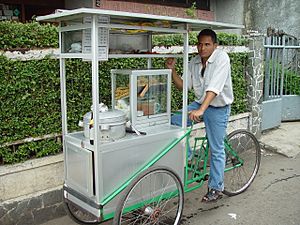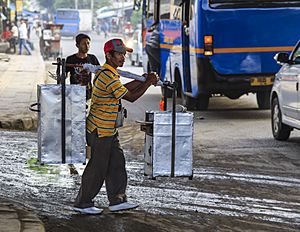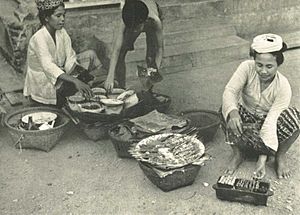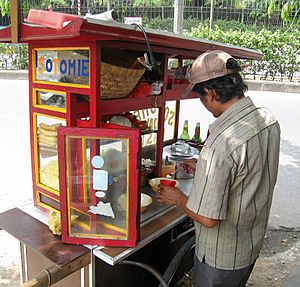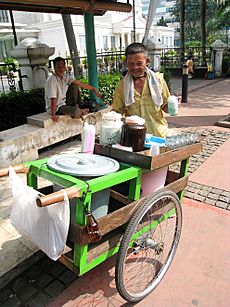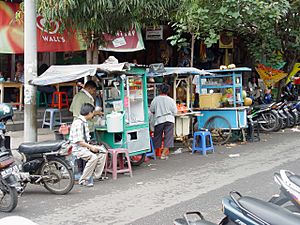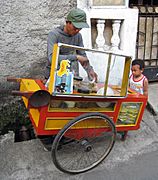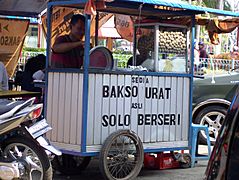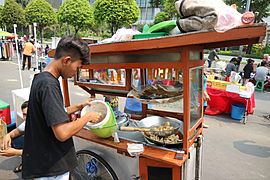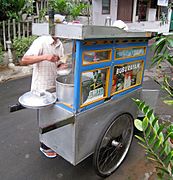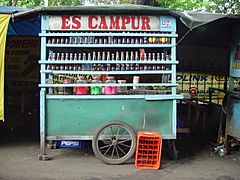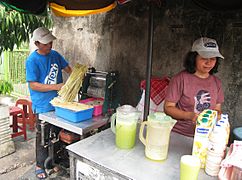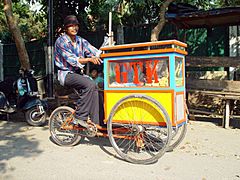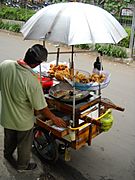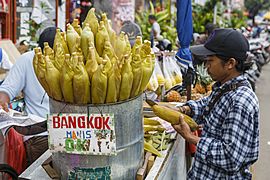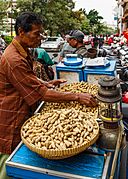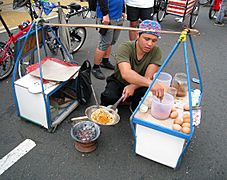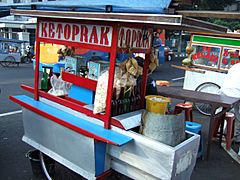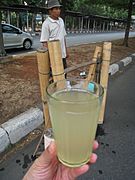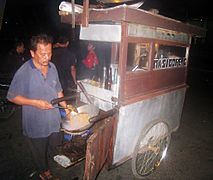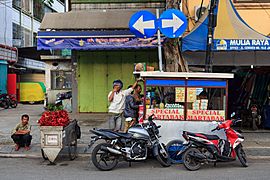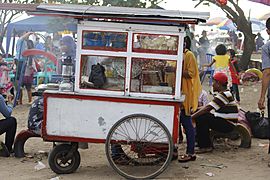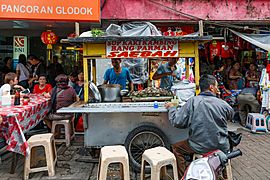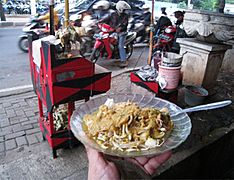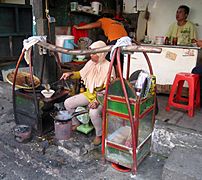Street food of Indonesia facts for kids
Indonesian street food is a super popular way to eat in Indonesia! It's all about tasty meals, snacks, fruits, and drinks sold by people called hawkers or vendors. You'll find them at small food stalls called warung or on cool food carts. This food is a fun mix of local Indonesian flavors, plus influences from Chinese and Dutch cooking. It's usually really cheap, has lots of different tastes, and you can find it almost everywhere in Indonesian cities.
Most Indonesian street food is very affordable, often costing less than a US dollar. People in Indonesia often call it kaki lima, which means "five-feet" in Indonesian. This name comes from the "five-foot way" pedestrian paths along the street where these vendors often set up shop.
In 2015, officials in Jakarta counted about 56,000 street vendors. But there were only spaces for about 18,000 of them! This means many vendors use the city's kaki lima sidewalks. The actual number of vendors is probably even bigger.
Indonesian street food often has strong and spicy flavors. A lot of it is fried, like different kinds of gorengan (fritters), nasi goreng (fried rice), mie goreng (fried noodles), and ayam goreng (fried chicken). Other popular choices include bakso meatball soup, traditional soto soups, and fruit rujak. Many Indonesian street foods use peanut sauce. For example, steamed siomay fish dumplings, grilled chicken satay, asinan, ketoprak, and gado-gado vegetable salad are all served with this favorite sauce. Some fried foods like gorengan and telur gulung (rolled deep-fried egg) are super tasty but can be a bit oily. Lately, some vendors in Jakarta are trying to offer healthier options too!
Contents
How Indonesian Street Food is Sold
You'll see street vendors everywhere in Indonesia, some walking and others using bicycles or carts. These carts are often called pedagang kaki lima. This name comes from the five-foot wide sidewalks they often use. Another idea is that "kaki lima" means "five feet" because it's the two wheels of the cart, plus a support foot, and the two feet of the person pushing it!
Different Ways Vendors Sell Food
There are two main ways street food is sold in Indonesia:
- Mobile (Traveling) Vendors: These vendors move around, often using food carts or bicycles. They might travel through neighborhoods, calling out to let people know they're there.
- Stationed Vendors: These vendors set up in one busy spot, like a street corner. They might have a simple seating area under a small tent called a warung. They wait for customers to come to them. During busy times, vendors often line up along roads to sell snacks to people passing by.
In Indonesia, you'll see many different types of food sellers:
- Pikulan: This is a traditional way where the seller carries two baskets or small cabinets balanced on a pole over their shoulder. You can see this method in old carvings from the 9th century! It's a very old way to sell satay.
- Sunggi and Bakul: Sunggi means carrying things on your head, usually on a tray. Bakul refers to woven bamboo baskets. This is common in places like Bali and rural Java. Women selling satay might carry raw satays, rice cakes, and peanut sauce on a tray on their head, while also carrying a grill and charcoal in baskets. They can walk around or set up in busy areas to grill satay fresh for customers.
- Gerobak: This is an Indonesian word for a wheeled food cart. It's a very common way for traveling vendors to sell food. These carts usually look similar, like a portable cupboard with drawers and glass to show off the ingredients. Some have a small stove for cooking. For example, a bakso cart has a big pot for meatballs, and a satay cart has a grill for charcoal.
- Sepeda and Becak: Sepeda means bicycle, and becak is a cycle rickshaw. Some vendors use bicycles to get around busy areas. The gerobak (cart) can be pushed or attached to a bicycle, making it a tricycle or a becak-like vehicle. Sometimes, motorcycles are used instead of bicycles.
- Warung: A warung is a simple shop. Many street food warung are just tents set up on the side of a busy street. But a small shop attached to a house can also be called a warung.
How Vendors Announce Their Food
Many street food sellers travel through neighborhoods to reach customers. They often have special calls or sounds to let people know what they're selling! For example, a satay seller might yell "tééé satééé!" A bakso seller might hit a wooden drum. A bubur ayam (chicken porridge) seller might tap the side of a soup bowl, and a mie ayam (chicken noodle) seller might hit a wood block.
A Look Back: History of Street Food
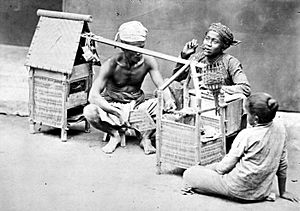
Street food has been a part of Indonesian life for a very long time! Old carvings from the 9th century on the Borobudur temple show people selling food and drinks. This tells us that small food businesses existed in ancient Java. Writings from the 14th century also mention food and drink sellers as a job in Javanese society.
Chinese street food culture also influenced Indonesia a long time ago, even during the Dutch colonial era. Many Chinese dishes like noodles, bakso meatballs, lumpia spring rolls, and steamed buns (bakpao) are common street foods today. Local Indonesian dishes also became street food. For example, satay is thought to have started as street food in the early 1800s, as a Javanese version of Indian kebabs. The Dutch also influenced Indonesian street food, especially with cakes and pastries. The popular kids' snack kue cubit is a local version of Dutch poffertjes.
The huge growth of street food in Indonesia today is also because many people have moved from rural areas to cities in recent years. This happened a lot in big cities like Greater Jakarta, Surabaya, and Bandung. As more people moved to cities, new jobs were needed. Many people started street food businesses, often selling foods from their hometowns. That's why in cities like Jakarta, you can find all sorts of dishes from all over the Indonesian archipelago!
In recent years, new influences from Western countries (like the United States), Japan, and the Middle East have also added to Indonesia's street food scene. You might see carts selling hamburgers, hot dogs, or grilled sausages next to traditional bakso carts. You might even find Turkish kebabs or Japanese takoyaki stalls. The flavors might be changed a bit to suit local tastes, like adding spicy sambal chili sauce.
What Kinds of Street Food Are There?
Main Dishes
Many Indonesian street foods are full meals made right in front of you. In most cities, you'll often see Chinese dishes like bakmie or mie ayam (chicken noodles) and bakso (meatballs) sold by vendors. These are often changed a bit to fit Indonesian tastes, for example, pork is rarely used because most Indonesians are Muslim.
Other popular Indonesian street food dishes include:
- Siomay and batagor (fried fish cakes)
- Pempek (deep-fried fish cake)
- Bubur ayam (chicken congee)
- Bubur kacang hijau (mung bean porridge)
- Satay
- Nasi goreng (fried rice)
- Soto mie (soto noodles)
- Mie ayam (chicken noodles)
- Mie goreng (fried noodles)
- Tauge goreng (mung bean sprouts and noodle salad)
- Asinan (preserved vegetable or fruit salad)
- Laksa
- Kerak telor (spicy omelette)
- Seblak
Snacks
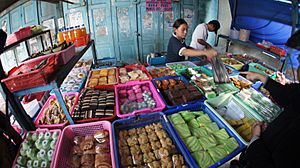
Traditional Indonesian cakes and cookies are called kue. The mix of kue sold in markets is often called jajanan pasar (market munchies). Other street snacks include pancakes like kue ape and serabi. You can also find Chinese snacks like bakpao (steamed buns with sweet or savory fillings).
Popular Indonesian street snacks also include:
- Gorengan (Indonesian assorted fritters) – these include fried tempeh, oncom, tahu goreng (fried tofu), pisang goreng (fried banana), fried sweet potato, and bakwan (fried dish of bean sprouts and batter).
Drinks
Some of the oldest street drinks are traditional ones like lahang (sugar palm sap) and tuak (palm wine), sold by vendors using big bamboo tubes.
Indonesian street drinks often include sweet, iced beverages that are almost like desserts! These include:
These drinks are usually a mix of shaved ice with lots of ingredients like fruit pieces, tapioca pearls, and grass jelly.
Fruit juices (jus) are also very popular. You can find juices made from orange (jus jeruk), guava (jus jambu), mango (jus mangga), soursop (jus sirsak), and avocado (jus alpokat). Avocado juice is often served with condensed milk and chocolate syrup, making it a sweet treat! Durian can even be made into an ice cream called es durian.
Challenges with Street Food
Keeping Food Clean
While many restaurants in Indonesia follow good food hygiene rules, some traditional food stalls and street vendors might not have the best hygiene. This can be a problem because it's hard to wash dishes properly without running water.
Sometimes, especially in tropical climates, germs can cause food poisoning. This is why it's usually safer to choose hot, cooked food from street vendors instead of cold or raw dishes. For example, eating hot mie ayam or soto soup is generally safer than having a cold salad like karedok or gado-gado.
Keeping Cities Tidy
It's common to see many warung (tented food stalls) and gerobak (food carts) taking up space on the kaki lima sidewalks in Indonesian cities. This can make it hard and even dangerous for people to walk, as they might have to step into the street because the sidewalks are blocked.
Indonesia, especially the island of Java, has always had many people, and food businesses have been part of its culture for a long time. But the huge number of people moving from rural areas to cities since the 1960s really shaped today's street food culture. As more people moved to cities, they needed jobs. Many started street food businesses, often selling foods from their hometowns. That's why in big cities like Greater Jakarta, you can easily find all sorts of traditional dishes from all over the Indonesian archipelago!
However, when so many kaki lima vendors, including food sellers, take over the sidewalks, it can create other problems for cities. City officials often try to clear the pedestrian paths and ease traffic. This can sometimes lead to disagreements between the city and the street vendors. Because of this, many cities are trying to find ways to better organize street food vendors.
Gallery
- Indonesian Street Food



